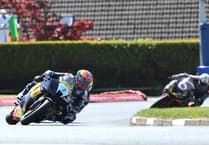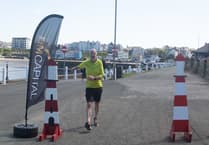A special ‘Made at the Manx Grand Prix’ Parade Lap is set to take place on Saturday afternoon as part of the event’s 100th anniversary celebrations. Road racing pundit Richard Radcliffe explains there are a couple of notable omissions from those honoured in the special lap.
The list of riders to be remembered in this year’s lap of honour was selected to celebrate those who had competed in the Manx Grand Prix before going on to ‘achieve great heights within the motorcycling world’.
As such it ignores the man with the most wins in the MGP proper (not including the Classic races) Denis Parkinson, the only treble winner, our own Dan Kneen, and the two men, who along with Parkinson, won races pre and post World War Two. Namely Ken Bills and Austin Munks.
Also ignored is the feat of Percy ‘Tim’ Hunt who set an outright course lap record in the 1928 MARRC (forerunner of the MGP Senior race).
Hunt went on to win two TTs and several races in the Continental Circus, which was the forerunner of the FIM World Championship.
One pre-World War Two MGP competitor is honoured by being named in the list – he is the great Freddie Frith.
He made his Grand Prix debut in 1930 and was on the pace immediately. He finished third in the Junior on a Velocette. He did not finish the Senior race.
He took another second place in the 1933 Junior. In 1935 he took the winner’s laurels in the Junior and then finished runner-up in the Senior race behind Dr Kelly Swanston.
On moving to the TT he excelled. In 1936 he won the Junior and was third in the Senior on works Norton machinery.
In 1937 he won the Senior, setting the first 90mph lap in the process. He was also second in the Junior.
He scored three more third-placed finishes before the war.
He returned in 1948 to win the Junior, but failed to finish the Senior.
He repeated this in 1949, the year in which he won every round of the 350cc World Championship.
One of the Pre-World War Two competitors not honoured is A. R. ‘Bob’ Foster.
Known as ‘Fearless’ he had a ‘win it or bin it’ approach during his early years of competing.
Like many of his contemporaries he began competing in trials, grasstrack races and scrambles.
Having accompanied a friend to the MGP, he was bitten by the bug and made his debut in 1933. It did not go well. Crashes meant that he did not finish a race.
In 1934, he finished second in the Lightweight MGP on what was in reality a works New Imperial. He was leading comfortably going into the last lap and followed pit instructions to ease back and save the machine. However, he overdid that to lose by 34 seconds. 1935 brought another ‘DNF’ due to a crash.
He moved to the TT in 1936 and found immediate success, taking his New Imperial to victory in the Lightweight race.
This was the last Lightweight win for a British machine until Steve Tonkin’s success on the Armstrong in 1981.
After war service in the RAF, he returned to racing.
He won the 1947 Junior TT and finished second in 1948 on Velocette machines.
1949 was a year dogged by machine failures especially at the TT where he led the Senior until a clutch failure sidelined him at Sulby on the final lap.
The 1950 TT brought more machine failures. Elsewhere it was a different story with victories in Belgium and Ulster he took the World Championship with 30 points.
Geoff Duke, who took his maiden 350cc win in Italy, was second (two points gross; six nett behind Bob) with Les Graham third.
After retiring at the end of the season, Bob did some service as a travelling marshal on the Mountain Course. He died in 1982 at the age of 71.
One of those honoured and rightly so is the oldest living FIM World Champion – one Cecil Sandford.
Sandford rode in the MGP in 1949 finishing a fine fifth in the Junior and 42nd in the Senior.
Moving to the TT he won the 125cc race in 1952 for MV and went on to win the World Championship.
His second TT win, the 1957 Lightweight on a Guzzi, heralded his second World Championship.
Keith Campbell, like Sandford, reached the pinnacle of motorcycle racing in the 1950s.
Keith was born in Praham near to Melbourne in Australia on October 2, 1931.
As a boy, he always dreamt of being a motorcycle racer.
He made his foray onto the European scene in 1950 and took fifth place in the Ulster GP Lightweight race on an Excelsior.
In 1951 he made his debut in the MGP but failed to finish the Junior race on his Velocette.
He returned in 1952 to finish sixth in the Junior (won by Bob McIntyre) on the Velocette and 14th in the Senior on a Norton. He entered the TT in 1954, but was sidelined by a crash in practice.
He did not enter the TT in 1955, but it was in this year that his performances on the Continent were noticed by the works teams. This included a third at Spa where he beat a number of the works team riders. He was suspended at the time of the 1956 TT for being part of the riders’ strike in 1955.
He was part of the works Guzzi team for the 1957 TT.
His pace in practice surprised the watching Geoff Duke who was suffering from a dislocated shoulder and unable to ride.
Bob McIntyre, on the works four-cylinder Gileras, won both the Junior and Senior races setting the first 100mph lap in the Senior.
After an eventful race, during which he was nearly run off the road when overtaking and then losing 200rpm due to a damaged valve, Campbell took second place in the Junior on the single-cylinder Guzzi ahead of Bob Brown (Gilera) and John Surtees (MV Agusta).
An amazing result for someone so short of course experience.
In the Senior TT, Campbell was the best of the single-cylinder riders finishing fifth behind Bob McIntyre (Gilera), John Surtees (MV Agusta), Bob Brown (Gilera) and Dickie Dale (Guzzi V8), that ran on seven cylinders for most of the race.
After the TT, Campbell used the Guzzi’s superior handling to defeat the more powerful multi-cylinder machinery and win the Dutch, Belgian and Ulster GP 350cc races.
He thus became the first Australian to become a world champion motorcycle racer. He also raced the V8.
He led two races and was closing on Surtees in his third, but the fragile engine failed to reach the finish in any of the races.
He married at the end of the season, his wife Geraldine was the sister-in-law of Geoff Duke.
After a honeymoon in Australia they returned to Europe for the racing season.
Guzzi, like Gilera and Mondial, had pulled out of racing leaving Keith as a privateer again.
He finished seventh in the Junior TT on a Norton ahead of future world champions Mike Hailwood, Jim Redman and Tom Phillis.
Sadly, this was to be Keith’s last race in the island.
In the next round of the world championship, he split the works MV Agustas of Surtees and Hartle at Spa.
On July 13 he raced at the Cadours circuit in France. He won the 350cc race, but in the 500cc he was brought down by an oil spill and died instantly in the accident. He was only 26 years old.
Why his name and that of Bob Foster is not included in the parade lap is a mystery.
Perhaps, in Keith’s case, the selection committee was unaware that an Australian rider had ridden in the MGP in the 1950s – surely it is not a deliberate omission.




